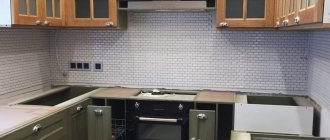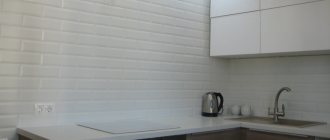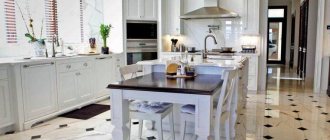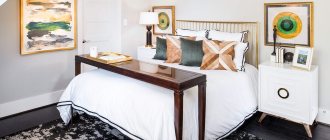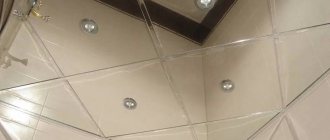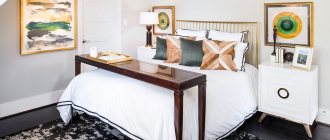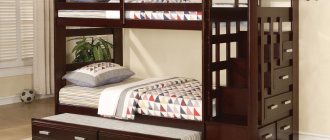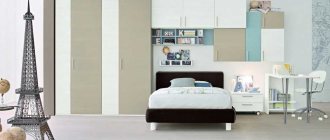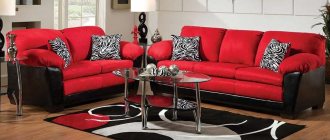Previously, it was believed that the use of tiles in a residential area should occur in certain areas; there was an opinion that they created cold and were not so beautiful in the interior, so much attention was not paid to the tiles, the same type of tiles down to the size and the same quality (composition). Over time, tastes and preferences began to change, and the taste for design skills and individual interiors returned to the country. Tiles began to be used not only in the kitchen and bathroom.
White glossy tiles in the living room
Geometric pattern on a black tile wall in the living room interior
Today, tiles are used to decorate walls in the living room (vertical, horizontal, patterned, prefabricated design), floors, fireplaces, built-in aquariums (reptile pool), arches, flower beds.
Classic style floor tiles in the living room
Patterned tiles in a classic living room interior
Over the past few decades, selection and production have grown so much that they represent a wide range. A huge number of different types of tiles and patterns on them impresses even the most fastidious buyers.
Checkerboard layout of tiles on the living room floor
Advantages and disadvantages
Ceramic tiles have many advantages:
| Advantages of use | Disadvantages of use |
| Rich in variety, the collections allow you to fit tiles into any style of living room. | Tile is a cold material and, if you do not install a heated floor system, it will be uncomfortable to be in such a living room. |
| Durable material will withstand any load. | The slippery surface of glossy tiles is dangerous; such products are not recommended for use in a home where there are children or elderly people. |
| The tiles are fireproof, so they are suitable for facing fireplaces. | Relatively high cost. |
| Ceramic products are easy to clean from dirt. | For high-quality cladding, it is better to invite specialists. |
What tiles can be used in the hall?
Let's consider the types of products that are suitable for finishing the floor and walls in the living room:
- Tile/ceramic tiles. Consists of a mixture of clay, sand and minerals. During the production process, it is fired and covered with glaze, thanks to which you can obtain any pattern on the surface and any texture. The most popular option.
- Porcelain tiles. Ceramics pressed with granite chips. It has exceptional strength and resistance to high temperatures. A variety of designs is also achieved by glazing the surface.
- Plaster. Eco-friendly material for high-quality imitation of brick or stone masonry on the walls of the living room. It is light in weight and comes in a wide range of colors. Disadvantages: fragility of the material, instability to moisture and a textured surface that accumulates dust.
- Clinker room. It is considered an improved type of ceramics, as it has a more complex composition. Thanks to prolonged firing and pressing, strong, wear-resistant products of various shapes are obtained. Convenient to install.
The photo shows a living room in neutral colors, where the TV area imitates a marble surface. This decoration decorates the room and attracts attention.
Advantages of ceramics as a finishing material
- Long service life - much better than linoleum or laminate;
- Resistance to mechanical damage - divided into 5 classes: AA (resistant to chemical agents) - A (product resistant to chemical agents) - B - C - D. The most common grades A and AA are used for both residential and public interiors;
- high abrasion resistance - the surface does not wear out, crack or fade when exposed to sunlight. It is divided into 5 classes - groups (0-1-2-3-4-5) - from purely wall application to high traffic areas;
- moisture resistant and hygienic. Tiles with a porous surface are characterized by high absorbency and, accordingly, low resistance to moisture - such tiles are best used for finishing rooms that do not have frequent contact with water - bedrooms, hallways, living rooms. For swimming pools, bathrooms, and kitchens, it is more practical to use ceramic tiles on a solid substrate with a water absorption of less than 3%;
- resistant to temperature fluctuations;
- fire-resistant - does not contribute to combustion;
- does not conduct electricity and is therefore used to create “warm” floors;
- availability - as a rule, in one series, manufacturers offer different brands - from inexpensive to elite;
- Environmentally friendly - not hazardous to health; natural materials such as clay, kaolin, feldspar and quartz sand are used in its production.
What can be tiled in the living room?
Based on their functional purpose, they distinguish between floor, wall and decorative tiles.
Floor
Due to high traffic, the living room floor covering must be resistant to damage. For safe movement, an anti-slip matte or rough texture is required. If the living room is combined with a dining room, the products should be easy to clean from dirt.
The photo shows a stylish living room with an unusual tiled floor. Shades of red brighten up neutral interiors.
Wall
For convenient cladding, wall tiles have a reduced weight. A fashionable trend is to decorate the wall in the form of a panel. Natural stone looks colorful in the living room interior.
Niche
Cladding a niche with ceramics is an original idea, as a result of which the wall in this area looks very impressive.
Fireplace
Due to their fire resistance, tiles are an ideal option for facing a fireplace. In addition, it transfers heat well and thereby increases its efficiency.
The photo shows a cozy cottage in a rustic style. A fireplace with bright decor adds a special touch to the interior.
Arch
Covering an opening with tiles imitating stone or brick can be called a classic. This is one of the most popular options for decorating an arch.
The photo shows a spacious living room that opens into a kitchen with an arch lined with rectangular tiles.
Color palette
Since the range of ceramic coatings on the modern market is wide, the choice of color scheme in the living room depends only on the taste of its owner.
- For connoisseurs of bright interiors, white, gray, beige tiles for floors and walls are suitable.
- Black color makes the space heavier, and it is also an impractical solution for the floor, since dirt and damage are clearly visible on it.
Today, manufacturers offer companion materials for wall decoration: pre-selected shades and patterns will help to professionally transform the interior of the living room.
The photo shows a bright living room with bright color accents. The “heavy” beamed ceiling is successfully compensated by the white floor.
Terracotta flooring is suitable for a country house: such a floor looks natural and cozy.
Tiles in rich colors - yellow, red, green - will become a bright accent in the interior. To avoid it being overloaded, the rest of the decor should be selected in neutral colors.
Trendy tile colors 2022
Designers are highlighting the hottest new shades of the coming year: gold and silver. Fans of darker colors should choose the following shades:
- black;
- Burgundy;
- violet;
- blue.
For rooms with small space, choose shades that will make the room appear larger, for example.
- champagne;
- pale yellow;
- beige;
- cream;
- Snow White.
Black
This color is worth considering separately, as it is complex and quite controversial, and should be used with caution. Black is an elegant and classic color, but on its own it can look dark, so it's best to pair it with other shades such as white, yellow or dark green. In this way, black can be transformed and become classic and interesting.
Under the tree
Today on the market you can find tiles that in no way resemble wood. This is a rather interesting solution that looks very original and interesting. Of course, it is not as good as natural wood, and is not able to fill the air with a pleasant smell. However, its use guarantees the creation of comfort in the home.
They are strong, durable and affordable.
Bright accents
Using bright accents helps break up the monotony of the design. For example, a bathroom in shades of beige will look more interesting with chic roses in shades of gold, light brown or soft yellow on the main wall.
White flowers against a simple brown shade look stunning. Monochrome mosaic tiles can also be used as an accent. In addition, it looks stylish and original.
Designers claim that absolutely any room can be transformed. All that is needed is high-quality finishing materials, and the appearance must correspond to the latest fashion trends in 2022.
In order not to make a mistake when choosing a tile design for the bathroom, you should familiarize yourself with all the recommendations and proposals of manufacturers and designers. Thanks to this, the renovation will be carried out quickly and efficiently, and the result will be a stylish and original interior.
Tile layout examples
The most common type of tile is square. It can be laid in the classic way (“seam to seam”) or diagonally. Products of various sizes and patterns are successfully combined. To create an unusual effect on the floor, tiles of the same shade are placed with a border instead of a plinth. Long rectangular products are usually laid “staggered” in imitation of natural materials: wood or brick.
The photo shows an interior where several types of tiles are combined. Figured and mirrored decorate the walls. Glossy porcelain tiles frame the contrasting wooden floor.
Variety of cladding materials
The construction market industry is rich in choice, and sometimes makes you rack your brain over what type of finishing to choose.
But once you start a renovation, there is no turning back, and you have to choose from what is available. And to put it mildly, there are plenty of options:
- Lining;
- Drywall;
- Decorative panel;
- Decorative plaster;
- Plastic panels;
- Ceramic tiles
- Plywood.
And these are just the most common types of building materials for decorating surfaces. The leader among the listed options is tiles for interior wall decoration.
Tile design
The varied shapes, textures and shades of ceramic coatings allow the apartment owner to decorate the living room in any way.
To expand the space of the room and give it airiness, the walls are decorated with mirror tiles. The wood-effect covering will add a touch of naturalness and comfort to the decor. You can also combine tiles with laminate by cutting out a curly line and covering it with an elastic threshold. “Marbled” products look great in the interior of the hall. To imitate carpeting, patterns with ornaments are used.
The photo shows an airy living room with sky-colored details. Mirror tiles emphasize the lightness of the decor and visually add space.
Connoisseurs of country style will love the cladding option in the form of panels made of combined tiles of different colors. This technique is called patchwork.
The shape of tiles today is the most diverse - designers offer not only squares and rectangles, but also rhombuses, honeycomb-shaped polyhedrons, and shaped products with rounded elements.
Using stone-like tiles, you can decorate the walls of the living room (either completely or partially), border windows, columns and doorways. Mosaic is suitable for facing fireplaces, as well as decorating walls: it is recommended to place it in inserts so as not to overload the space.
Types of tiles that are always relevant
Imitation marble and stone
Imitation marble, sandstone, onyx or travertine are perhaps the most striking examples of timeless tiles.
Today, thanks to unprecedented progress in tile production technology, ceramic imitations are difficult to distinguish from the original. Manufacturers have learned to copy with amazing accuracy not only the color and pattern of natural stone, but also its texture.
Stone tiles create a beautiful and calm backdrop for expensive sanitaryware and furniture. They enrich both minimalist styles and elegant, classic interiors.
Ceramic parquet
Like porcelain tiles, wood-effect floor tiles are always in style, regardless of passing trends. High quality wood effect floor tiles can be used in any room, from the bathroom to the bedroom. It can be used for both walls and floors.
Monocolor tiles
For square tiles of bright colors in the 10×10, 20×20 or 30×30 format, the name “monocolor” has been established. It can often be found in both private and public interiors.
Several colors are often used in styling to create an ornament or to highlight functional areas. One popular technique is alternating black and white tiles in a checkerboard pattern.
English style tiles
English style tile collections usually consist of square background tiles: plain, striped, dotted, diamond or fleur-de-lis, as well as wide borders, baseboards and bases.
The classic English tile pattern involves a combination of two types of pattern: several rows of background tiles with a lighter pattern below, and then a border and a lighter tile above it. Skirting boards and baseboards are optional.
Antique style tiles
Luxurious collections of antique-style ceramic tiles, reminiscent of Roman and Greek interiors, also retain their value for many years. It is not surprising - the masterpieces of past eras, which served as a source of inspiration for designers, have been admired for several hundred years.
“Subway” or “hog” tiles
Rectangular tiles with rounded edges, uniformly colored, have many names: “metro”, “boar”, “bicelado”. Such ceramics were first used to cover the subway in Paris. Tiles with interesting shapes quickly gained popularity. Today it is used to decorate bathrooms and kitchens. Subterranean tiles give the interior a slight vintage character.
Kitchen-living room tiling ideas
If the apartment has a living room combined with a kitchen, tiled flooring will suit perfectly. A standard practical option is a kitchen apron. Recently, the rectangular “hog” has gained popularity: it looks advantageous in any style.
The photo shows a kitchen-living room, decorated with hexagonal “honeycombs” in pastel colors. They protect not only the walls, acting as an apron, but also the floor.
Porcelain tile flooring in the kitchen area is a good idea for practical people. Wear-resistant porcelain tiles will not wear out, absorb moisture and grease, or deteriorate under the influence of cleaning agents. Also, in a large room, zoning can be easily done using tiles.
In the photo there is a kitchen-living room, the division of zones occurs by combining floor tiles of different colors and shapes.
Tiles on the wall: why and what for
By improving their skills and coming up with more and more new design options, professionals make a much wider choice. Who would have thought a few years ago that the walls of a room could be covered not only with wallpaper, but also with tiles and a combination of materials.
Tiles are a reliable and durable material that will serve you for many years.
Why is it more profitable to decorate a wall with tiles? There are several reasons for this:
- The choice of colors and designs is very wide. You can choose what suits your tastes and preferences;
- Using this material you can easily delimit the zones of the room;
- The tile is resistant to external influences. She is not afraid of sudden changes and temperature changes. Thanks to tiles, you can install a fireplace in your living room without worry;
- The tiles are easy to clean. Simply run a damp cloth over it and all dust and dirt will be removed;
- The tile looks elegant and pompous;
- It will last you much longer than any other material.
Thanks to tiles, you don’t have to think about repairing and decorating walls for many, many years.
Photos of the living room in various styles
The tiles in the living room will fit well into the modern style. It is characterized by minimalism and clear lines. For the living room, a monochromatic covering without pronounced patterns is suitable, which will serve as a backdrop for an advantageous display of furniture and accessories.
The classical direction is the complete opposite of the modern. Classic interiors are replete with decorative details. For finishing, materials are suitable that will emphasize the nobility and tranquility of this style: light colors, patterns, marbled imitation. For the floor, a good solution would be a coating that imitates dark parquet.
French Provence is popular with people seeking home comfort. Ceramics with stone and wood textures, as well as floral patterns or sketches of rural life, will help serve these purposes.
Loft-style tiles are widely used: imitation brickwork has become the hallmark of this trend. Large ceramic rectangles in gray colors look original and convincingly imitate a wall made of concrete blocks.
High-tech is characterized by functional design details and geometric shapes. Its main idea is the reflection of modern technologies in the interior. Rounded furniture and spotlights in combination with mirrored wall coverings will be an excellent solution for this style. A 3D tile with a three-dimensional multidimensional pattern will fit well.
The photo shows a loft-style attic, boldly combining tiles with both a pattern and imitation brick.
Ceramic tiles 2022 – choice of color palette (photo)
Modern, fashionable ceramic tile designs 2022 will help you highlight your interior in the right places and make your living space more stylish and cozy.
For an interior with a modern, minimalist character, tiles that imitate raw concrete are ideal. However, this does not exclude artistically incorporated wall decor - it does not violate the harmony, but gives the interior a cozy character.
White color never goes out of style. Thanks to its modern design, white is not boring. White tiles can be combined: for example, matte tiles can be combined with glossy ones. A mix of different sizes and shapes also works well. The brave soul can choose colored grout, which gives plain white tiles a personal touch.
Regardless of the color choice, ceramic tiles 2022 can be combined with a structured surface in a certain part of the room. Designers usually choose one area to highlight - for example, behind the bathroom. A structured wall further emphasizes the interior. If the choice of tiles is well thought out and matches the rest of the decor, you will enjoy them for years to come.
One of the most beautiful tile collections, Ceramic Tile 2022 is a combination of tiles in soft, beige and brown shades. The classics can be complemented with decorative elements with a pattern of a warm, golden hue. This interior is pleasant, warm and relaxing.
Rustic tiles in this style bear the marks of time. Sometimes an original design goes well with an unusual format, such as 20x60. Choosing such tiles allows you to stop time in the interior, giving it a timeless character.
Fashionable ceramic tiles 2022, imitating white brick, are very popular and often become the main element of arranging a bathroom or kitchen.
The right piece of furniture in shades of white or light wood can add harmony to the interior. Brick tiles are versatile and suit both rustic and modern interiors.
Many people have a penchant for natural materials. Since it is not possible to use natural wood in a bathroom, wood tiles are the ideal solution. You can experiment with the shape of wood-look tiles: make a floor that imitates parquet or just planks.
As you know, natural stone is expensive, but, nevertheless, many people like this material. Currently, the technology for producing tiles that look like natural stone has improved. They can replace granite or marble.
Beautiful hexagonal ceramic tiles 2022 have created a new aesthetic in modern interior design. These tiles will look good in the living room. You can find a variety of sizes and colors to use on both the wall and floor. This tile can confidently be called the trend of the year.
